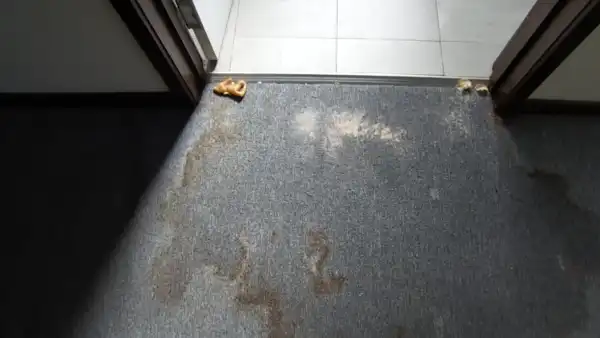Last Updated on October 18, 2023
Suddenly growing mushrooms in your bathroom can be a shock to discover. These elusive fungi thrive in a place where you least expect them. As seeing them in your personal space is disturbing, understanding mushroom growing causes makes it easier to remove them.
The presence of fungal spores can be a key factor as they can easily enter your bathroom through various sources. Also, organic material, such as wood or drywall, provides a food source for the mushrooms to grow. Low humidity and no ventilation also make mushroom growth easy.
Today, we will explore some major reasons mushrooms might grow in your bathroom and provide insights on how to prevent this fungal intrusion. So continue reading to keep a clean and hygienic bathroom.
Why Are Mushrooms Growing in My Bathroom: Common Reasons with Solutions

If you’re wondering why mushrooms are growing in your bathroom, several factors must be considered, such as:
- Presence of fungal spores
- Presence of organic material
- High humidity
- Lack of proper ventilation
- Damp building materials
- Low lighting
- Poor maintenance
1. Presence of Fungal Spores
The presence of fungal spores in your bathroom can lead to the growth of mushrooms. These microscopic spores are everywhere, including in the air you breathe.
When they find their way into your bathroom, they can remain dormant until germination conditions are favorable. Also, these spores are highly resilient and can survive for extended periods without proper conditions for growth.
To prevent the growth of mushrooms in your bathroom, using a bleach solution (one part bleach to ten parts water) can help kill existing mushroom spores and prevent their regrowth.
2. Presence of Organic Material
Mushrooms require a food source to grow, and organic materials provide just that. When these materials are present in bathrooms, they create an ideal breeding ground for mushroom spores to attach and thrive.
The decomposition process of decaying wood or paper releases nutrients that nourish the spores, allowing them to develop into mushrooms.
By eliminating these food sources, you can disrupt the lifecycle of mushrooms in your bathroom. Ensure to keep bathroom clutter to a minimum and avoid storing organic materials in damp areas.
This will prevent mushroom growth & mold development and avoid attracting insects and bugs such as ants, roaches, and spiders.
3. High Humidity
Bathrooms are naturally humid environments due to activities like showering and bathing, creating ideal conditions for mushroom growth. The constant exposure to water and steam increases the moisture content in the air, providing an optimal habitat for mushroom spores to take root and flourish.
Maintaining humidity levels below 50% in your bathroom discourages the proliferation of mold and fosters a less favorable environment for fungi to thrive. Using a hygrometer, you can accurately measure the humidity levels in your bathroom.
Installing an exhaust fan can effectively remove the moist air from the bathroom, reducing humidity levels and preventing surface condensation. Using the ventilation fan while taking showers or baths and for some time afterward is recommended to ensure that excess moisture is expelled outside.
Opening windows can also help improve airflow and allow fresh air to circulate, reducing the chances of mushroom growth.
4. Damp Building Materials
You should be aware that continuous exposure to moisture can affect the building materials in your bathroom. When drywall, wooden framing, and other porous materials come into contact with water, they become susceptible to damage and even mushroom growth.
These materials can absorb water, creating a damp environment that promotes fungal growth. Inspecting and addressing any areas where these materials are consistently damp is important. This may involve repairing leaks, improving ventilation, or using moisture-resistant materials in high-humidity areas.
5. Low Lighting
Mushrooms thrive in low-light conditions and can easily establish themselves in a bathroom’s damp and dark corners. You can create a less favorable environment for mushroom development by providing indirect lighting.
Indirect lighting refers to using light fixtures that are not directly exposed to the affected areas but illuminate them indirectly through reflection or diffusion. This helps to minimize the darkness in these corners and reduce moisture buildup, making it less likely for mushrooms to grow.
6. Poor Maintenance
Poor maintenance creates an environment that is ideal for mushroom growth. Neglecting to fix leaks promptly allows moisture to accumulate, allowing fungi to thrive. You can also cause fungus to grow in your bathroom if you don’t clean and disinfect your bathroom regularly.
Regular maintenance must be performed on your bathroom to prevent the growth of fungi. Make bathroom maintenance a routine part of your household chores.
What happens if I breathe mushroom spores?

Breathing mushroom spores can adversely affect your health due to the release of mycotoxins. When you inhale these spores, they can enter your respiratory system and cause various diseases.
Toxic pneumonitis is a condition characterized by inflammation of the lungs, leading to symptoms such as coughing, shortness of breath, and chest pain. Hypersensitivity pneumonitis is another respiratory disease caused by an immune response to fungal antigens, resulting in fever, chills, and muscle aches.
Also, exposure to mushroom spores has been linked to tremors, chronic fatigue syndrome, kidney failure, and even cancer. Take proper precautions when dealing with mushrooms growing in your bathroom and avoid inhaling their spores to protect your health.
How do you tell what kind of mushroom it is in my bathroom?
Take a close look at the size, color, and shape of the cap and stem and whether the underside has pores, gills, or teeth to identify which mushrooms are in your bathroom. Examining these characteristics will aid in determining its species.
The cap’s size can vary greatly among different mushrooms, ranging from small to large diameters. Colors can range from white to shades of brown or even vibrant hues like red or orange. The shape of the cap can be convex, flat, or even funnel-shaped.
Pay attention to the stem’s height and thickness as well. The presence of pores, gills, or teeth on the underside of the cap is crucial for identification purposes.
Keep Your Bathroom Mushrooms Free With Proper Cleaning
Mushrooms in your bathroom are a sign of specific environmental issues that must be addressed. To prevent their growth, maintain proper ventilation, promptly repair any water leaks, and ensure that building materials in the bathroom are not continuously exposed to moisture.
Regular cleaning and disinfection can help eliminate fungal spores and maintain a dry, healthy bathroom environment. Also, ensure proper humidity levels to avoid any potential health risks associated with mushroom spores.
Understanding and addressing these reasons lets you keep your bathroom free from unexpected fungal guests.

